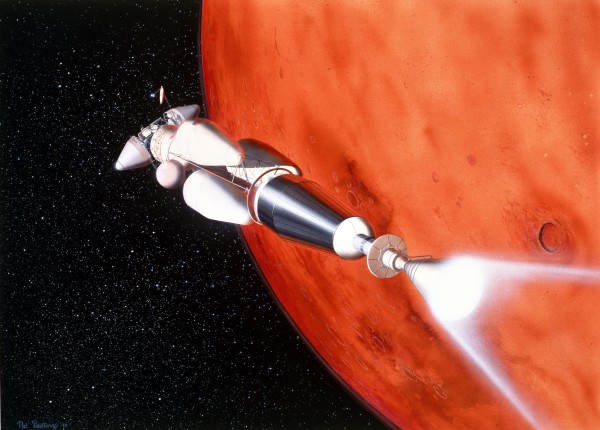A revolution in the way we conduct deep space exploration may soon be upon us thanks to recent advances in lightweight materials, the advent of small, inexpensive satellites called ‘Cubesats’ and a renewed willingness by policy-makers to consider new technologies and approaches. Many of these new technologies are in the area of propulsion for a spaceship or satellite which is already out of Earth’s atmosphere, and are considered ‘propellantless’ because they don’t use fuel in the conventional sense. NASA’s George C. Marshall Space Flight Center in Huntsville, Alabama, USA, is at the forefront of development many of these new space propulsion technologies.
Since the beginning of the Space Age, we have explored space using exclusively rockets propelled by chemical energy and more recently using rockets that accelerate their exhaust electromagnetically. The former are simply called chemical rockets and the latter are generically called electric propulsion. In recent years there have been significant technological advances in both that dramatically increase our ability to explore the solar system.
Next Generation Rockets
Chemical rocket propellants may be solid, like the ammonium perchlorate used in the Space Shuttle Orbiter’s solid rocket motors, or liquid, like the hydrogen used by the Orbiter’s main engines. While ammonium perchlorate is a powerful rocket propellant and was responsible for providing more than 80% of the total lift-off thrust for the Space Shuttle, it is also toxic. Hydrogen, on the other hand, produces steam, water vapour, as it burns with liquid oxygen (also carried by the Shuttle). Unfortunately, for most deep space applications, relatively toxic propellants like hydrazine and nitrogen tetroxide are frequently used, posing storage and handling risks for all directly involved. There are efforts to develop and demonstrate less-toxic ‘green’ propellants, but these are not yet in wide use.
Nuclear rockets use the heat of a nuclear fission reaction to heat propellant and expel it as exhaust rather than using the heat generated via chemical combustion. The advantage with this approach is that the propellant can be heated to much higher temperatures, and the atomic weight of the propellant can be optimized to provide the maximum thrust for the least mass. In nuclear rockets, the optimal propellant happens to be hydrogen. The US last tested nuclear thermal rockets in the 1960’s and 1970’s under Project NERVA (Nuclear Engine for Rocket Vehicle Application) before the project was cancelled due to the ending of Project Apollo, and the subsequent lack of defined missions for it. Since then, studies consistently show that such rockets are among the best for sending a mass into deep space efficiently, such as would be required for a human mission to Mars.

While there is currently no full-scale nuclear rocket program, engineers at NASA are testing system elements using low-cost, simulated nuclear reactors to avoid the safety, cost and complexity issues associated with nuclear testing to develop fuels that offer superior performance over what was available nearly a half-century ago. The reactor technology for nuclear rockets is not much different from that used in today’s nuclear power plants. Both use the fissioning of uranium to generate heat, but space nuclear reactors will be much smaller than their ground-based analogues. It is important to note that any nuclear rocket would not be engaged until the spacecraft is well out of the Earth’s atmosphere, posing little or no risk to our environment should there be an accident.
Solar electric rockets are the most efficient rockets known today and, for propulsion in deep space where distances are vast, efficiency is king
Solar electric rockets are the most efficient rockets known today and, for propulsion in deep space where distances are vast, efficiency is king. Rockets that provide the most thrust for the least mass are the ones that have the highest payoff in this type of exploration. Using technologies originally developed for nuclear physics research, particle accelerators, and adapting them for spaceflight has led to a method of space propulsion that is about ten times more efficient (per kilogram of fuel) than any chemical rocket. Powered by sunlight, these electric rocket engines use electric and magnetic fields to accelerate ionized propellant to very high exhaust velocities, providing a small but continuous thrust that enables very large changes in spacecraft velocity.
The noble gases are the best propellants for these engines. Argon, xenon and krypton are generally nonreactive, fairly easily ionized, and can be accelerated to very high exhaust velocities resulting in a relatively high momentum exchange between the propellant and the spacecraft. To date, electric propulsion systems have flown on several space missions, most of which are commercial communications satellites in Earth orbit. Larger and more capable systems are planned for use in deep space. For example, NASA’s recently announced Asteroid Redirect Mission (ARM) is currently planning to use high-power solar electric propulsion to alter the trajectory of an about 400t asteroid and place it on a safe trajectory into lunar orbit.
The problem with rockets, both chemical and electric, is that they all-too-soon run out of fuel. Most people are unaware that when a robotic mission is launched to Mars, nearly all of the acceleration of the payload occurs within the first few minutes of flight before the chemical propulsion system onboard the spacecraft shuts down due to lack of fuel. The rocket and its payload then coast for the next several months at a constant velocity until the spacecraft uses another rocket to place the ship into orbit or to target its planetary entry for landing. Electric propulsion systems are more efficient in using propellant and about ten times more efficient in changing spacecraft velocity, but their performance is still limited by the amount of fuel they can carry onboard. And many destinations of interest for scientists require propulsive manoeuvres beyond what either type of rocket can provide.
Star Sailors
A possible solution to the fuel burn out can be provided by ‘propellantless’ propulsion systems like solar sails and electrodynamic tethers. Though their fundamental physics of operation are very different from each other, they have in common a lack of need for propellant because neither of them expel any sort of rocket exhaust in order to derive thrust and hence movement. All of these systems also take advantage of the space environment itself for propulsion, making them perhaps the ultimate in ‘green’ propulsion for space.
Solar sails use reflected sunlight to propel vehicles through space. Incident light reflects from a mirror-like sail made of a lightweight, highly reflective material and imparts momentum to the sail in the process. Although light has no rest mass, it does possess momentum and as long as sun shines on the sail, it will move. This continuous thrust allows solar sails to perform a wide range of missions, many of which are simply impossible using chemical propulsion – the rocket will run out of gas before the mission is complete. In the near-term, solar sails will be used to study the Sun and the Earth from unique vantage points. Eventually, a solar sail propulsion system could propel a spacecraft to reach tremendous speeds – potentially allowing us to send a spacecraft to visit another star or solar system.

Solar sails are conceptually simple and have been discussed as a theoretical possibility for nearly a hundred years. However, they have only been practical in the last few decades due to recent advances in highly-reflective, lightweight and high strength-to-weight materials. Studies and tests of polymide film-based materials, such as LaRCT-CP1, developed by NASA’s Langley Research Centre and fabricated by DuPont, show that sails can be made to be very robust, to withstand a very wide range of temperatures and to be unsusceptible to damage from solar wind, micrometeors, or solar ultraviolet radiation exposure.
Japan has been flying the world’s first solar sail, called IKAROS (Interplanetary Kite-craft Accelerated by Radiation of the Sun), since 2010. In 2014, NASA will launch its first deep space solar sail, the Sunjammer, on a demonstration mission that will take it toward the Sun. Sunjammer is over 1,200 square meters in area and uses inflatable booms, similar to balloons one might find at a fair, only much more sophisticated, to support the sail. Beginning in 2014, Europe has planned a series of small solar sail flights that will incrementally increase in size and capability.
A possible solution to the fuel burn out can be provided by ‘propellantless’ propulsion systems likesolar sails and electrodynamic tethers
Electrodynamic tethers use the force exerted by a magnetic field, such as Earth’s, on a current-carrying wire (the Lorentz Force), and represent an interesting alternative to conventional rocket engines for missions in Earth orbit. When this force acts on a current carrying wire attached to a spacecraft, it will either accelerate or decelerate the spacecraft in its orbit, lowering or raising its orbital altitude – using no propellant in the process. Only sunlight converted to electrical power is required. Tethers, which may need to be many kilometers in length for operational systems, need to be resistant to damage from micrometeors and orbital debris. Tethers may one day be used to transfer working satellites to new orbits, remove dead satellites from orbit at the end of their life, keep space stations and space hotels in orbit, and even provide propulsion and power for vessels orbiting the other planet in the solar system with a large magnetosphere: Jupiter.
The fundamental physics of electrodynamic tethers have been proven in space on numerous test flights, including the 2010 flight of the suborbital JAXA T-Rex mission. The T-Rex was launched from Japan on a sounding rocket and demonstrated that a long (400 m) conductive tape can be deployed in space and collect ampere-level currents – a critical step toward developing a tether-based propulsion system. The next step, which has not yet been funded, is a demonstration of the tether’s ability to actually boost and de-boost a functioning satellite in a controlled fashion.
To Infinity and Beyond
The future of deep space exploration using conventional chemical rockets is far from certain, yet it is expected that they will remain the mainstay of space exploration for many years to come. However, in the very near future they will no longer be humanity’s only means of travel within our solar system.
For example, solar sails will enable spacecraft to remain directly above the Earth’s polar regions, balancing solar pressure on the sail against the pull of Earth’s gravity and preventing the sail from either falling to the ground or flying off into space. Electrodynamic tethers may enable spacecraft to fly at very low altitudes in the ionosphere, using their inherent propulsive capability to prevent them from re-entering the Earth’s atmosphere due to the very high atmospheric drag at those altitudes. Solar electric propulsion will be used to launch more payload mass, in some cases more than twice the mass that can be sent by chemical propulsion, to destinations all over the solar system.
In general, these new technologies are much simpler and less expensive to build and operate than today’s state-of-the-art chemical propulsion systems. Hence, although overall funding for developing new space technologies is scarce, these technologies and others are mature enough to be considered real alternatives to chemical propulsion in the near term and are receiving varied amounts of research and development funding from NASA, ESA (European Space Agency) and other space-related organizations all over the world.
As many of these new propulsion technologies become viable alternatives, they will enable exploration of regions of deep space simply inaccessible with conventional technology.








